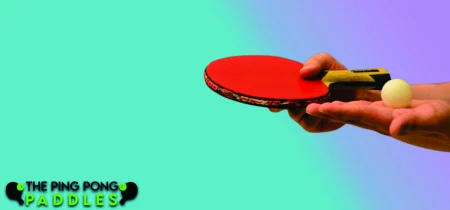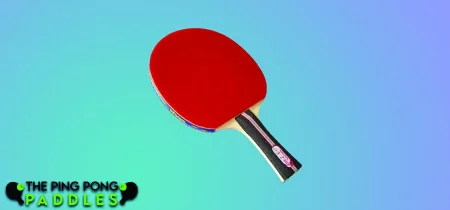Before we begin, it’s crucial to remember that how to pick the Best Ping Pong Paddles is also called by a variety of other names, some of which may be confusing, such as paddle, racket, bat, or racquet. The sport is governed by the International Ping Pong Federation. The official ITTF handbook (https://www.ittf.com/handbook/) refers to it as a Ping Pong Paddle. This course employs a lot of jargon, but don’t worry, it all refers to the same thing!
In this post, we’ll go over everything you need to know about buying how to Pick choose a ping pong paddle and the best one for your game. If you want to skip the science and get straight to the paddle recommendations, check out the table of contents below.
How to Choose a Ping Pong Paddle:

Ping pong, or Ping Pong as it’s known across the world, is a fast-paced, entertaining tabletop game that can keep two players entertained for hours. Ping pong can be played practically anyplace, from your local sports club or pub to your own garage, thanks to the relatively small size of a ping pong table and the little amount of equipment necessary.
All you need to play ping pong is a table, a ball, and a paddle for serving and returning the ball. Choosing the right best ping pong paddle requires analyzing your specific playstyle, experimenting with various materials, and determining what feels best in your hand.
What is a ping pong paddle made of?
While you’re thinking about ping pong paddles, it’s a good idea to first understand what one is and what goes into making one. Sure, studying the different pieces of a ping pong paddle isn’t the most exciting aspect of the buying process, but it will help you choose the ideal one for your skill level and playing style.
Blade:

The blade is the most important portion of a paddle. It is commonly composed of wood, however official ITTF specifications allow for a small amount of substitute fibrous materials, such as carbon fiber or compressed paper, to be used. Other materials shall account for no more than 7.5 percent of the overall thickness of 0.35mm, whichever is less, in a Ping Pong blade.
A ping pong paddle may be any size, shape, or weight as long as the blade is flat and robust, which may surprise you. Typically, blades are made up of 5 or more thin layers of wood or other material. The most prevalent blades on the market are 5- and 7-ply, and a combination of soft and hardwoods, as well as composite materials, assist to develop a paddle’s performance.
Carbon vs. Wood:

Carbon and wood vary mostly in terms of predictability. Because wood is a natural substance, it is non-uniform in nature. Simply told, a blade made of wood is one-of-a-kind, but with time and experience, you’ll discover its peculiarities and become accustomed to it. Although all blades must be composed of at least 85 percent wood, the minor amount of carbon fiber will give the paddle more predictability.
Choosing a ping pong paddle with carbon fiber in the blade will, on average, provide:
- precision
- uniform bounce
- stability
- speed
Consider the STIGA Carbon racket, which has a 7-ply blade with 5 layers of wood and 2 layers of carbon fibre, making it stiffer and allowing for improved speed and power.
Rubber:

Rubber must be equally applied to the side of the blade that makes contact with the ball. There are two sorts that are allowed:
- Ordinary pimpled rubber:
It’s a single layer of non-cellular rubber, either natural or synthetic, with equally dispersed pimples (known as ‘pips’) with a density of 10 to 30 per square centimetre. The pimples can face in (so you can hit the ball with them) or out (so you can hit the ‘sponge’ with them) (see Sandwich rubber below). Rubber pip is another name for it.
- Sandwich rubber
A single layer of cellular rubber (also known as a “sponge”) is covered by a single outer layer of conventional pimpled rubber with a thickness of less than 2mm. The thickness and density of this sponge layer of rubber influence the ball’s speed. More speed equals a thicker sponge (because the ball bounces off the bat quicker)A thinner sponge provides more control (because the ball is slower to bounce, giving you more time to react). Beginners will benefit from a more controllable paddle, like the Butterfly Timo Ball 1000, which has only 1.5mm of sponge. More experienced players, on the other hand, can try a thicker sponge.
- Faced Rubber
You have the option of having two distinct rubber coatings on either side of your Ping Pong blade or keeping the front and rear the same. Look for the ITTF emblem on the rubber if you’re purchasing anything other than a cheap bat: this indicates that the rubber fulfils ITTF competition standards, so you won’t have to get too technical about the rubber thickness. Oh, and there’s another requirement:
The rubber must be black on one side and red on the other. And it’s not only for the sake of looking cool. The ITTF implemented the colour rule so that your opponents may better estimate your speed and spin by knowing which side of your bat you’re using (if your bat has two rubbers). Nobody knows why the colours red and black were chosen. Some bats are black on both sides or red and green on one side; you may still play with these, but you won’t be capable of competing in competitive events, therefore I wouldn’t suggest them to a serious player.
Handle:

A Ping Pong bat’s handle is linked to the blade. Straight, anatomic, flared or penhold, covered or exposed, short or long – there are no rules; it’s all up to you. There are four major varieties of ping pong paddle handles. Paddle handles are commonly abbreviated as FL (flared), ST (straight), and AN (anatomic). So, how do you decide which handle to use? There is no simple solution, and it all boils down to your unique tastes, but you may learn a lot from what other ping pong players are doing.
When to choose a penhold handle?
The Penhold handle is a short handle designed for players who want to use a penhold grip. It’s as simple as it sounds to hold the paddle like a pen (or pencil!). It’s so common among Chinese and Hong Kong Ping Pong players like Wong Yun Chin that it has its own name: the “Chinese penhold grip.”
The benefits of the penhold grip are:
- Enables the wrist to stay flexible (allowing more spin).
- maintains the paddle’s proximity to the table
The penhold grip, on the other hand, makes applying backhand spin harder.
The following are some examples of rackets having penhold handles:
- Butterfly 2000 with penhold handle
- DHS A4006 with penhold handle
When to choose a flared handle?

A flared handle is somewhat longer than a penhold handle, and it’s ideal for beginners since the flared ends keep the paddle securely in your grasp (compared to a straight handle).
It’s also the most frequent handle on paddles in the low to mid-price range. Flared handles are also better for players who don’t change their grips very often and are perfect for front hand players. Butterfly’s Timo Boll collection, for example, has flared handles on all of its products.
When to choose a straight handle?

Straight handles are preferable for players who shift their grips, whereas flared handles are excellent for forehand strokes and beginners. What are the drawbacks of a straight handle? It’s more prone to slip out of your grip, making it a little more difficult to handle.
Straight handles are used by the vast majority of professional players. There aren’t as many straight-handled Ping Pong paddles on the market as there are flared-handled paddles, but certain intermediate bats, such as the Killerspin Kido 7P, provide an option of flared or straight handles. If you buy a blade and create your own paddle, you’ll have even more options (see the section below).
When to choose an anatomical handle?
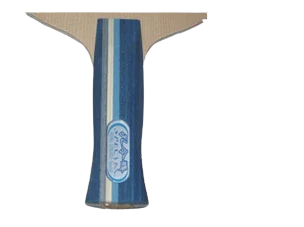
Isn’t it true that straight handles are difficult to come by? When it comes to anatomical handles, that’s nothing! Anatomical handles are simply meant to be more comfortable in your hands. Anatomical handles, such as flared handles, are best for players who maintain a consistent grip. Although there are few distinctions between the two styles, flared handles are significantly more common.
Square vs. Rounded handles:
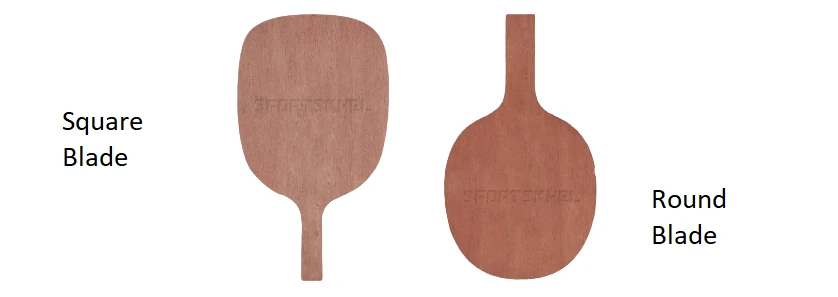
The majority of paddles have rounded handles, which means the edges are curved. A rounded handle is comfortable in the hand and allows a player to swiftly change grips by flipping the paddle over.
Grip Tape:

Many players choose to play with a racket that has a grip on the handle for greater control. Handle grips are often fitted to any paddle and do not come standard with the racket. Ping Pong grip tape, such as this Butterfly grip tape, is what it’s known as.
Glue:
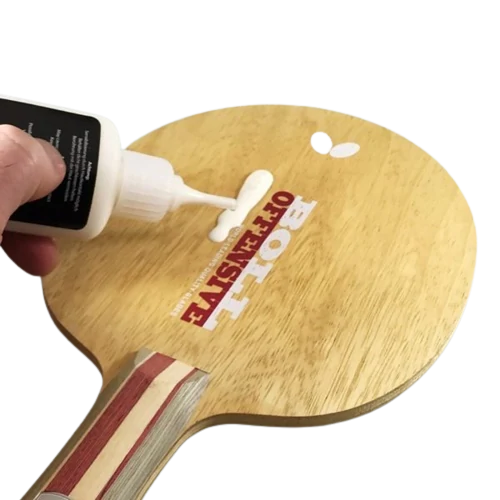
Glue is used to adhere the Ping Pong rubber to the blade. There are certain types of glue used in ping pong (not simply regular superglue or craft glue), and a relatively new form of glue known as speed glue was once used by pros to improve the flexibility of their rackets before a match, but it was outlawed by the ITTF in 2009.
Side Tape:

The side tape, also known as edge tape, is the last component of a ping pong paddle. It seals the rubber sides and covers the blade’s edge. The thickness will be determined by the blade and rubber thickness. Power tape, which adds weight to the bat, is used by some players.
Choosing a Paddle to Suit Your Playing Style:
Types of Grip: How Do You Hold Your Paddle?
The sort of blade handle your paddle should have is determined by how you grip it. A Ping Pong bat can be held in one of two ways: As we previously discussed, the Penhold grip entails gripping the paddle like a pen or pencil. It’s a grip that was formerly popular among Chinese players but is now much less so (none of the world’s top 20 female players uses it, according to the ITTF).
The Shakehand grip is a straightforward grip in which the index finger is stretched over the rubber and the other fingers are wrapped around the handle. The majority of European players use it, and it allows for equal power delivery for both forehand and backhand shots. The majority of amateurs and professional players employ the shakehand grip. Timo Boll’s grip is shakehand.
Timo Boll employs the shakehand grip. Choose a ping pong paddle with a comfortable handle for you to hold. The penhold grip needs the use of a penhold or short handle, whereas the shakehand grip necessitates the use of a bigger handle (which can be straight, flared or anatomical).
Aggression level:
Aggression in Ping Pong may be classified into the following categories:
- Protective
- All-around player (or Counter-Attacking)
- Combative (also called Offensive, Attacking)
An all-rounder style of play is used by the majority of beginners and intermediates. On a sliding scale, the heavier the racket, the more forceful the paddle. Choose a racket with a mid-weight for beginners. A heavier racket will assist more advanced aggressive players. Remember that you may pack on even more weight by using power tape.
Speed, Spin and Control:
With so many different ping pong paddles to pick from, it may seem hard to choose the correct one. To make things easier, a ping pong paddle has three key purposes; understanding each one will help you choose the correct bat.
1. Speed:
Rackets can assist you in hitting ping pong balls quickly or slowly. The type and thickness of rubber used to cover the bat will determine this.
- Thicker rubber has more speed
- Rubber that is thinner has a lower speed.
2. Spin:
The thickness of the rubber on your paddle, similar to speed, determines how many spins you can produce on the ball — the thicker the rubber, the more spin you can generate.
- Thicker rubber has more spin
- Thinner rubber has less spin
3. Control:
The shape of a paddle will determine how much control you have over the ball. Control, spin, and speed are frequently traded off: the more control you have, the less speed and spin you can generate. A novice should opt for a high control grade, and as they advance, they may add more speed and spin.
- Thicker rubber has less control
- Thinner rubber has more control
TIP: Beginner players will benefit from a bat with thin rubber since it will give them more paddle control (1.5mm). As the intermediate player gains control, they can graduate to a thicker rubber and begin to incorporate speed and spin into their game.
What do those performance ratings mean?
While looking for a ping pong paddle, you’ll most likely come across a ‘rating system.’Is there a ping pong paddle rating system that is official and standardized? No. Because bats are assigned ratings by their manufacturers, it’s difficult to evaluate performance between brands just on these figures.
To choose the ideal racket for your skill level and playing style, examine each paddle’s precise specs individually – compare rubber thickness, blade composition, weight, and grip type.
Choosing a paddle Type:
1: Figure out what grip you want to use:
Consider your playing style and how different types of paddles may impact your outcomes. Choose the traditional grip that feels the most natural to you. The “shakehand” grip is the most common in the Western world, and it derives its name from the way holding your play hand mimics shaking hands with someone you’ve just met. Other players may feel more in control if they use a “penhold” grip, which consists of clutching the handle between the thumb and forefinger like a pen and holding the paddle downwards.
- Before selecting which grip is best for your game, try serving and returning the ball with each grip a few times.
- A shake hands grip allows you to make more forceful returns and put more spin on the ball, but a penhold grip places the arm in a more natural position for rapid, brush strokes.
2. Start with a basic plastic or wood paddle:
When you’re just learning how to play, get the cheapest paddle you can find. These simple paddles are normally built from a single piece of molded plastic or a few thin pieces of wood, and they have no extra features or aesthetics. They may be really useful when you’re just getting started, and you won’t have to spend a fortune on a paddle you won’t be able to use.
- A simple, inexpensive paddle can educate you to be more exact since you’ll be compelled to strike the ball directly every time you serve or return.
3. Buy a ready-made commercial paddle:
A garden-type packed ping pong paddle may be found in the tabletop games area of any sports goods shop. These paddles are often manufactured in a cookie-cutter fashion, with identical dimensions, materials, and a crude rubberized surface layer. A basic store-bought paddle will do for the vast majority of recreational players.
- Ping pong is a game where technique is more important than equipment. With a store-bought paddle, a good player can dominate.
- Commercial paddles may be found for a low price and are occasionally offered in pairs or with ping pong balls.
4. Try out a competition paddle:
Pick up a competition-grade paddle if you find yourself going through commercial paddles too rapidly or simply want something a little more durable. Competition paddles must be made of at least 85 per cent natural wood, according to the official table tennis regulation, so they’ll be a little heavier.
- Paddles are also made with higher-quality rubbers and adhesives, ensuring that they will last longer and withstand more vigorous play.
- Professional paddles may normally be found where basic commercial paddles are sold, or they can be ordered online.
Finding a Reliable Paddle Surface:
1. Play with a rubberized paddle to increase control:
Make sure that the paddle you’re using has rubber on at least one side. A thin strip of rubber is bonded to the flat surface of most ping pong paddles. This provides you with better control over the ball by adding traction to the paddle’s face. If you want to use a lot of spins to change the pace and direction of the ball, you’ll want to look for a paddle with some nice, gripping rubber.
- Controlling the ball means being able to direct it where you want it to go at the pace you want it to travel, without having to worry about it slipping or deflecting off the paddle.
- These days, almost all ping pong paddles are rubberized.
2. Look at different rubber textures:
To modify the way you handle the ball, use a textured paddle. Some paddles feature textures called “pimples,” “dimples,” or “waffling” that hold the ball and help it cling temporarily after it makes contact, in addition to the rubber layer. A textured paddle may make a major difference for defensive players and others who want to control the tempo of the game.
- You’ll get more traction with a textured paddle, but you’ll lose some speed and sensitivity on returns.
- For players that employ a lot of spin tactics, deep textures are not advised.
3. Consider how thick you want the rubber sponge to be:
Decide if a larger or thinner rubber sponge would be preferable for you. The sponge sits beneath the rubber’s outer surface, absorbing impact and providing grip and control. It also affects how quickly the ball can be retrieved. The paddle is heavier and denser with thicker sponges, allowing you to smash the ball faster. Thin rubber layers, on the other hand, give sensitivity and allow you to slow down a little.
- You may choose the sponge thickness in addition to the kind, softness, and texture of the rubber.
4. Replace your paddle or rubber when it becomes worn out:
The more you use a paddle, the faster the rubber surface will start to wear down. Replace the rubber and sponge or spend some money on a new paddle if this happens. Rubber that has been worn down to a thin layer loses a lot of its grip and spring, putting your technique at risk.
- Look for areas where the texture has been flattened away or seems less prominent.
- If you often use professional paddles, replace them when the previous one wears out. If you use a bespoke paddle, remove the old rubber and replace it with a new one.
Using the Right Paddle for Your Play Style:
1: Select your custom materials:
To fine-tune their performance, more experienced players typically choose and choose the materials that go into making their paddles. Choose a type of wood for the paddle’s structure, a rubber that offers you the ideal mix of speed and control, and other components that change the paddle’s specifications. Select and assemble each component independently to create your paddle.
- Carbon fibers, which boost the paddle’s strength and give it more snap, and compressed paper, which decreases the paddle’s weight, are two other materials utilized in ping pong paddles.
2. Choose a paddle that’s designed for your preferred grip:
Although all ping pong paddles have the same fundamental form, certain models differ in blade width or handle length and design to better suit various play styles. Find a paddle with a thick, strong handle to give your stroke some authority for a typical shake hands grip. If you like to play with your hand in the penhold position, choose a lighter paddle with a longer, narrower grip that allows for fast wrist brushing strokes.
- Some paddles are specifically built for players who prefer to use a penhold grip. These paddles are longer and more ergonomic, with an additional fin of wood around the grip for enhanced security.
3. Decide whether you want rubber on one or both sides of the paddle:
You’ve discovered a wooden paddle you like, but should you rubberize both sides or just one? This is primarily a personal choice. Although the extra rubber and sponge will increase the overall weight of the paddle, you will have better control when switching between forehand and backhand strokes. You may also rubberize both sides of the paddle, but with distinct textures and thicknesses on each. When you need to make different shots, you’ll be able to swap between both sides of the paddle.
- Competitive players frequently utilize two different rubbers on their paddles, each with somewhat different qualities, to enable them to employ more diverse techniques.
4. Experiment with different sizes and weights:
Ping pong paddles come in a range of sizes, shapes, and styles. Before settling on a favorite, it’s a good idea to try a few other kinds. For offensive players who rely on speed to win games, heavier paddles are ideal, whereas defensive players benefit with lighter, more flexible paddles that allow them to control the ball’s pace and direction. Experiment with different weights and sizes of paddles when you get the opportunity until you find what works best for you.
- The weight of a paddle is determined by its thickness. Thicker paddles allow you to push the ball quickly while sacrificing control. Thinner paddles provide maximum control over the ball, but they return a lower ball speed.
Beginner’s Guide:
1. Parts of a Ping Pong Paddle:
A racket is made up of three major components: the blade, the wooden piece, and the rubbers that cover both sides of the blade.
1. Blade
Table tennis rules stipulate that rackets must be made of at least 85 percent natural wood. The remaining 25% is frequently constructed of composite materials such as carbon fiber, which strengthens the paddle and gives a large sweet spot, or analyte, which has a softer feel than carbon and aids in vibration dampening. Beginners should not get one with carbon layers just yet since they need to enhance their abilities and playing style.
2. Rubber
Rubbers come in a variety of textures, including smooth, reverse, pimpled, and pips. Start with a high-quality smooth rubber on both sides, since this will allow you to experiment with different play techniques before settling on one for professional usage. Pimples or short pips are only suitable for a narrow range of strokes and spins and are best suited to more specialized playing techniques.
3. Sponge
A sponge layer ranging in thickness from 1.2 mm to 2.5 mm sits between the rubbers and the blade. A thin sponge layer provides you more control and is excellent for beginners who are still learning the game, whereas a thicker sponge layer gives you less control but faster speeds and is best for more experienced players.
4. Price
While it may be more cost-effective to get the greatest quality you can afford, you don’t have to buy the most costly ping pong paddles to play effectively. Even if you’re a novice, selecting a bespoke bat over a pre-made bat is a requirement if you’re serious about improving your abilities and playing style.
A custom-made paddle may be more expensive than a pre-made paddle, but it has the added benefit of allowing you to replace old or broken rubbers and upgrade parts as your skills improve. After purchasing your blade, rubbers, and sponge, you must use a special adhesive to assemble them.
Manufacturers occasionally provide assembly as a service to their customers; otherwise, having it done by someone who knows what they’re doing will save you money in the long run. Investing in appropriate table tennis racket covers also protects them from the sun, liquid spills, and other harsh elements, allowing them to endure longer.
Experts Guide:
Table tennis is the world’s most popular racquet sport because it provides hours of fun as well as a complete physical workout while also pushing your talents. Because your racket is so vital to your talents and strategy, deciding whether to purchase a pre-made or bespoke paddle or its constituent parts requires some thought.Here are some expert advice for choosing the best ping pong paddles:
1: Selecting rubber:
Rubbers can be found on both sides of the paddle surface or blades and come in a variety of shapes and sizes:Smooth inverted and sticky: These are the most popular rubbers for offensive plays because they provide rapid speeds, strong strokes, and forceful spins.
Pips or pimpled rubber surfaces allow for quicker, more direct strokes while also counteracting the opponent’s spin for excellent defensive play. Anti-spin rubber is great for defensive play since it reverses the opponent’s spins. Most competitive players, on the other hand, combine anti-spin with lengthy pips for superior game control.
2. Choosing the blade:
At least 85 percent of the blades must be made of natural wood. The rest of the blade might be made of glass or carbon fiber composite materials. Carbon blades are stronger and have a larger sweet spot. Beginners and recreational players, on the other hand, may no longer be bewildered when it comes to choosing the right blades or materials since manufacturers now provide speed ratings to help buyers. A slower blade, on the other hand, offers more control, whilst a faster blade is ideal for offensive shots but lacks control.
3. Choosing the sponge:
A sponge layer 1.2 mm to 2.5 mm thick sits between the blade and the rubber. A narrow sponge provides greater control, whereas a thick sponge delivers more speed but less control.Recreational players can still purchase pre-made ping pong paddles for their convenience since they are increasingly being created using high-quality materials. However, if you want to improve your game, investing in a custom-made racket is more cost-effective in the long term because rubbers are easy to change as your abilities progress.
Questions To Ask When Looking For the Best Ping Pong Paddles:
With the top ping pong paddles costing over $100, a ping pong paddle may be a significant investment in your game. However, before you spend so much money on just any old paddle, think about a few things.
1. What is your level of play?
If you’re just starting up or deem yourself a casual player, the best ping pong paddles for you will be less expensive—you can acquire high-quality paddles for under $50 if you deal with a reputable seller. These paddles will be sent completely assembled. If you’re a professional or a competition player, you’ll need a much stronger paddle.
Professional players frequently purchase the blade (the wooden component of the paddle) and the rubber separately and assemble them. Butterfly, for example, sells both recreational and professional ping pong paddles.
2. Are You Planning To Play In Tournaments?
If this is the case, familiarise yourself with the ping pong paddle competition regulations. In general, there are no size or weight constraints. The majority of competitive paddles are built with the rough surface towards the wood and the smooth area facing the outside for shakehand grips. However, these are more like preferences than regulations.
The paddle has to be red on one side and black on the other. There’s also a rule that the rubber can’t even touch anything besides wood, so if your blade has a carbon or arylate layer in the middle, make sure it’s a thin layer and the rubber doesn’t come into contact with it. If you do not comply, you may be eliminated from the game.
The best ping pong paddles for major tournaments may be found on the sites of reputable table tennis merchants.All bets are off if your racket hasn’t been used in a contest, and you can use any paddles you like.
It might be challenging to choose the best ping pong paddles, especially if you are new to the game. The most essential thing to know is that an amateur should not spend more than $50 on equipment; this will get you a solid paddle and allow you to play for hours. To increase their chances of winning, a professional table tennis player is likely to invest several hundred bucks on the best ping pong paddles accessible.
Recommended Ping Pong Paddles For You:
Here are several paddles that I would recommend for all levels of players, including beginners, intermediates, and experienced. Paddles are covered by several suppliers, and you should do your research to choose the best one for you.
Entry-level:
1. JOOLA Winner
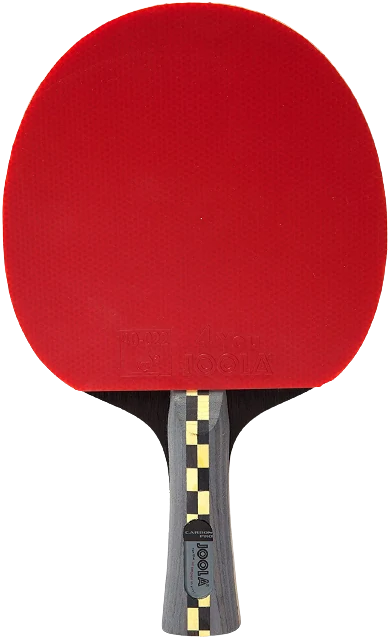
This is a JOOLA leisure paddle. The unique ergonomic grip design allows you to quickly adjust to hand. Over the sponge, the paddle has a smooth pips-in rubber called “Compass.” It is appropriate for your children to utilize when they first begin playing ping pong.
2. Butterfly Nakama S-5

Pan Asia rubbers inverted red and black were used on this paddle. The handle has a flared shape that provides an excellent grip for players. This paddle gives you a lot of control.
3. Killerspin JET 200

The Killerspin JET is the Killerspin series’ entry-level paddle. The JET 100 is the most affordable. If you wish to play the game for fun, a somewhat better paddle, the JET 200, is advised.With this paddle, you may choose between three distinct rubber colors. In addition to the classic red, you may choose from a range of colors, including blue and green.
4. Donic Waldner 700

With this paddle, you can generate some decent speed and spin. You can also exert effective control over it. With this paddle’s built-in balancing mechanism, the racket may be rather hefty. When grabbing the paddle, the flared handle design may create a comfortable experience.
Beginners:
- Killerspin JET 600:
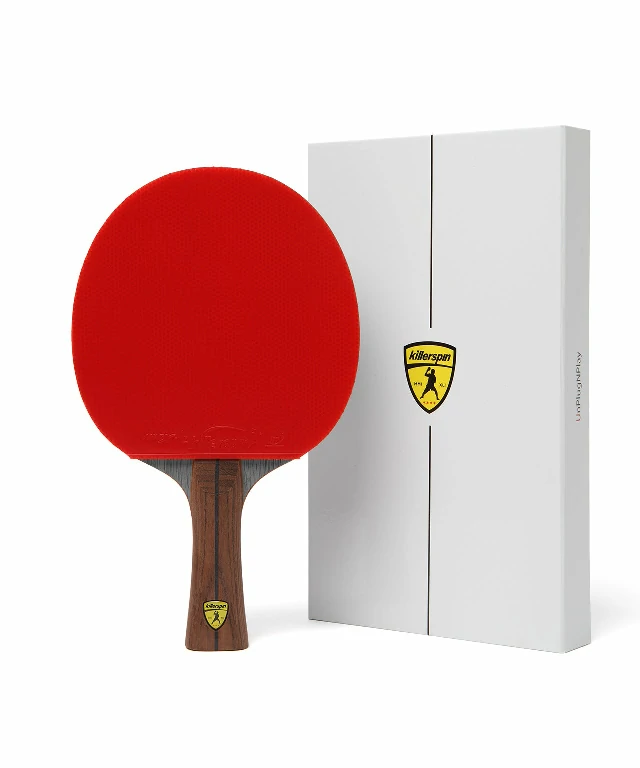
Killerspin is a table tennis brand from the United States. The business operates in the recreational table tennis segment. Most of their bats are called “paddles” to match their pitch to the basement market in the United States. The paddles are of decent quality, however, they are more expensive than other manufacturers.
The dimensions of this Killerspin Jet 600 are 6.1 x 10 inches, and it weighs 9.4 ounces. Some players enjoy the added weight, while others are not accustomed to it. The weight of this racket gives superb attacking and puts a strong spin on the ball, according to players who enjoy it.
However, players who aren’t fans of it argue that it causes their strokes to strike straight rather than curve since it’s heavier than most other rackets, allowing opponents to smash back and rebound quickly.
2. STIGA Evolution:

This is a fantastic pre-assembled ping pong paddle that provides excellent control. It’s being made and designed to assist players to improve their overall stroke. In comparison to other STIGA paddles, the STIGA Evolution is built with control in mind.
3. JOOLA Spinforce 300

The JOOLA Spinforce line has three racket types that are specifically developed to meet the needs of various players. There are three models: 300, 500, and 900. The paddles’ manufacturing quality is top-notch, and they’re made with a high-quality rubber that’s specifically engineered to accommodate players of all skill levels. The Joola Spinforce 300’s overall design is incredibly interesting and lovely. It is built of wood and foam and is lightweight. Although it is technically a 5-ply blade, you can only see three layers with your eyes.
Intermediate:
1. STIGA Pro Carbon:

This STIGA Pro Carbon paddle is a high-quality paddle with an ergonomic shape that feels great in your hand. You can play ping pong for an extended period without becoming tired of it.It has a large handle yet is light in weight. It may provide you with excellent balance and is appropriate for usage at home.
2. Butterfly 401:

Butterfly has released the 401 shakehand racket, which is another high-quality racket. On both sides, it’s made of incredibly sticky Butterfly Yuki rubber. With its 2.1mm sponge layer, the rubber can provide players with a lot of spins.
Nonetheless, the tackiness may fade over time. Because you get a cover with the racket when you buy it, it’s a good idea to keep it covered while it’s not in use the blade is made of five layers of wood and has a bigger sweet spot.
It is perfect for novices because it is available at a reasonable price. The fact that the ITTF has not approved this racket is a disadvantage for you. As a result, you can use it in tournaments. In addition, the racket may be rather hefty, weighing in at around 180g.
3. Killerspin JET 700:
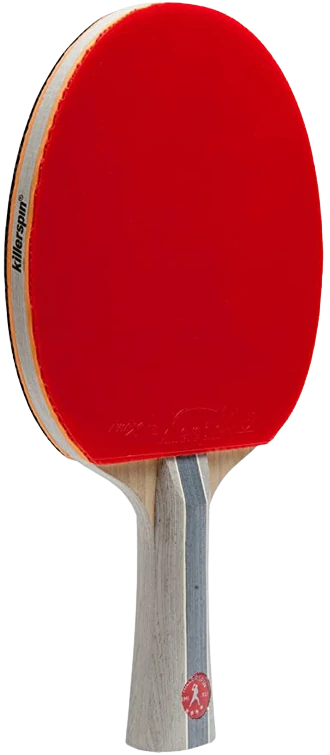
The racket is made of high-grade materials. Both sides of the blade include two Nitrx-4Z rubbers with a 2.0mm thickness. The Killerspin JET 700 racket is made for competitive club players. For some people, it may be as expensive as a pre-made racket, but you will receive the speed and spin you desire for the amount you spend.
Advanced:
- Killerspin JET 800:

This is a top-of-the-line pre-assembled racket designed for intermediate to advanced players. Both sides of the blade include two Nitrx-4Z rubbers with a 2.0mm thickness. The rubbers are black on one side and red on the other. It is also authorized by the ITTF.The Killerspin JET 800 blade is made of 7-Ply, which consists of 5 layers of wood and 2 layers of carbon. The dimensions of the head are 6 x 6 1/8 inches.
2. JOOLA Spinforce 900:

This is the Spin force series’ most advanced level racket. The racket is made of JOOLA Infinity rubber and 7 layers of carbon plywood. The rubber is comprised of a maximum soft sponge, allowing players to have good ball spin and control. This racket is designed for advanced players that require a high level of speed, stability, and strength. It’s ideal for those offensive players that want to go all out.
Frequently Asked Questions
Which Grip Do You Use?
The shakehand grip, in which the paddle is gripped as though shaking hands, is the most common nowadays, and it is the ping pong grip that most table tennis paddles were created for.However, some players, particularly those from Asia, employ the penhold grip. The player clutches the paddle handle like a writing pen, as the name indicates. Because penhold players are often quick on their feet and avoid striking backhands, only one side of this paddle may be covered with rubber.Unless you’ve been taught to employ the penhold grip by an Eastern instructor, the finest ping pong paddles for you are likely to be those that accommodate shakehand grips.
When to choose a straight handle?
Straight handles are preferable for players who shift their grips, whereas flared handles are excellent for forehand strokes and beginners. What are the drawbacks of a straight handle? It’s more prone to slip out of your grip, making it a little more difficult to handle. Straight handles are used by the vast majority of professional players.There aren’t as many straight-handled table tennis paddles on the market as there are flared-handled paddles, but certain intermediate bats, such as the Killerspin Kido 7P, provide an option of flared or straight handles. If you buy a blade and create your paddle, you’ll have even more options (see the section below).
When to choose an anatomical handle?
Isn’t it true that straight handles are difficult to come by? When it comes to anatomical handles, that’s nothing! Anatomical handles are simply meant to be more comfortable in your hands. Anatomical handles, such as flared handles, are best for players who maintain a consistent grip. Although there are few distinctions between the two styles, flared handles are significantly more common.
How do I choose a ping pong blade?
If you consider yourself to be an all-around player, an all-around wood would be your best bet. If you are an attacking player, go for a speedier blade with a speed rating of at least 70. The majority of the 5 ply blades are all-purpose (50-70). 7 and 9 ply blades are quicker and stronger for attacking play.
Conclusion:
In conclusion, we hope that this article has provided you with some insight into what to look for when purchasing the best ping pong paddles. We understand that sifting through all of the options might be overwhelming, so we’ve worked to filter it down to a handful of the finest options.
It’s tough to say which is the best because it is entirely subjective. Defensive players should target anything that has a lot of spins but isn’t as fast as the ball to slow it down. Aggressive players, on the other hand, will want power. We’ve covered all you need to know about buying a ping pong paddle and how to pick the ideal one for your game in this article.






